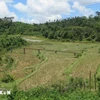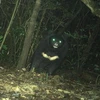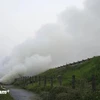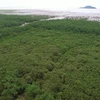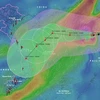More than 129 Cao Vit gibbons, one of the world’s rarest primate species, are being protected in Trung Khanh district of the northern mountainous province of Cao Bang, as part of a project launched by Fauna & Flora International (FFI) in 2004.
According to elderly people in Ngoc Khe, one of the three communes preserving the gibbon community, the no-tail and black or yellow species were seen in thick forests long ago. Local residents called them “Cao Vit” or “Cao Huyt” as these words sounds like their howls. However, as time passed by, the primate population decreased due to deforestation.
In 2002, the FFI discovered the gibbons still inhabiting the Ngoc Khe, Ngoc Con and Phong Nam communes of Trung Khanh district. Two years later, the organisation found around 37 individuals, and set up a project in March to restore and expand the habitat for the primates.
In 2007, FFI helped Cao Bang province establish the Cao Vit Gibbon Conservation Area, which covers nearly 3,000 ha in the three aforesaid communes.
Nong Van Toa, director of the area’s management board, said since the 2004 project was activated, local residents have been supported with effective ways to improve their living standards. They no longer have to go to forests for firewood, Toa added.
Livestock interest groups have been developed to reduce farmers’ dependence on forest resources. Additionally, over 200 households have been equipped with breeding and cultivating techniques.
Besides Cao Vit gibbons, the conservation area is home to many other rare animals such as monkeys, bears and deer, all of them well protected by local people.-VNA
According to elderly people in Ngoc Khe, one of the three communes preserving the gibbon community, the no-tail and black or yellow species were seen in thick forests long ago. Local residents called them “Cao Vit” or “Cao Huyt” as these words sounds like their howls. However, as time passed by, the primate population decreased due to deforestation.
In 2002, the FFI discovered the gibbons still inhabiting the Ngoc Khe, Ngoc Con and Phong Nam communes of Trung Khanh district. Two years later, the organisation found around 37 individuals, and set up a project in March to restore and expand the habitat for the primates.
In 2007, FFI helped Cao Bang province establish the Cao Vit Gibbon Conservation Area, which covers nearly 3,000 ha in the three aforesaid communes.
Nong Van Toa, director of the area’s management board, said since the 2004 project was activated, local residents have been supported with effective ways to improve their living standards. They no longer have to go to forests for firewood, Toa added.
Livestock interest groups have been developed to reduce farmers’ dependence on forest resources. Additionally, over 200 households have been equipped with breeding and cultivating techniques.
Besides Cao Vit gibbons, the conservation area is home to many other rare animals such as monkeys, bears and deer, all of them well protected by local people.-VNA



